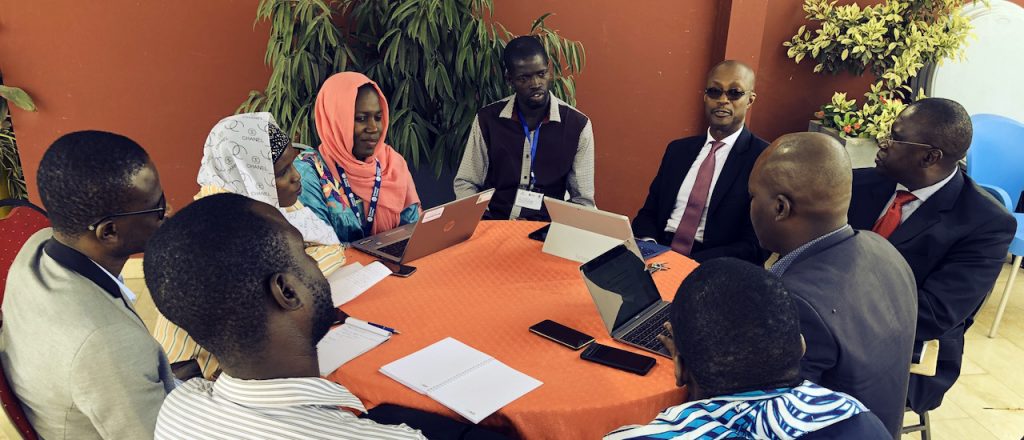Etcd Joins CNCF’s Growing Cache of Open Source Projects
 Etcd is the primary storage location for Kubernetes and needs to be established before Kubernetes can be run on a system.
Etcd is the primary storage location for Kubernetes and needs to be established before Kubernetes can be run on a system.
How SDN and Blockchain can help with IoT Privacy and Security?
The main reason that blockchain can be considered for IoT security and privacy is that blockchain has built-in data protection and security mechanisms.
Ciena, Juniper Lead Data Center Interconnect Market, Dell’Oro Says
 Data center interconnect equipment revenue will increase 85 percent over the next five years, from $2.7 billion in 2017 to $5.1 billion in 2022, according to Dell’Oro Group.
Data center interconnect equipment revenue will increase 85 percent over the next five years, from $2.7 billion in 2017 to $5.1 billion in 2022, according to Dell’Oro Group.
Huawei Flags 5G Network Slicing Landmark, Signs New 5G Deal
 Amid all the political noise, Huawei ploughs on regardless with a further advance in 5G network slicing and a new 5G network deal with Altice Portugal.
Amid all the political noise, Huawei ploughs on regardless with a further advance in 5G network slicing and a new 5G network deal with Altice Portugal.
Arista Works With Red Hat and Tigera on Container Environments for Enterprises
 The collaboration focuses on the three biggest container pain areas for enterprises: 1) networking; 2) visibility; and 3) security.
The collaboration focuses on the three biggest container pain areas for enterprises: 1) networking; 2) visibility; and 3) security.
Tusheti Community Network One Year Later: Creating Impact, Sustainability, and Scalability

Connecting the most remote and challenging territories of any country to the Internet can be tough. Typically, Internet access spreads gradually from urban conglomerations towards smaller hubs, and finally, to the most remote and sparsely populated areas. This is just common business sense.
Many of these remote areas are unique in terms of their people, culture, and livelihood, and Internet access can make a world of difference. This was the case when the Internet Society, together with its local partners, launched the first community network in Georgia, in the mountainous region of Tusheti, in September 2017.
Creating Impact
One year on, the Internet has made a significant difference to the lives of the Tushetians. This week, the Internet Society published an impact assessment on the Tusheti community network highlighting the transformation in tourism, e-commerce, and people’s livelihoods.
The Internet has had a positive impact on tourism through more effective online advertising and sales, and through efficiencies in businesses operations. With these encouraging developments, local residents are investing in the construction and opening of new guesthouses. The Internet has also increased the levels of safety and mobility in this remote part of the world by providing a communications channel to Continue reading
Headcount: The Latest in Firings, Hirings, and Retirings — December 11, 2018
 Joe Cozzolino departs Cisco to join private equity firm; CenturyLink CTO joins the MEF board of directors.
Joe Cozzolino departs Cisco to join private equity firm; CenturyLink CTO joins the MEF board of directors.
Tech Bytes: HPE’s Composable Fabric For Data Center Automation (Sponsored)
On today's Tech Bytes, sponsored by HPE and Intel, we explore HPE's Composable Fabric. It combines top-of-rack switches and automation software to pool networking resources and help your data center scale. We also discuss how Composable Fabric integrates with Simplivity, HPE's hyperconverged platform.
The post Tech Bytes: HPE’s Composable Fabric For Data Center Automation (Sponsored) appeared first on Packet Pushers.
Are Huawei Products Unsafe or Insecure ? A Review

I’ve done quite a bit of research in the Huawei issue. There are two key areas that I will cover in this review of the available information. The network has to work before it can secured. Software Quality and poor process. Insider Threats by Chinese Nationals. TL:DR Huawei has substantial problems with product quality and […]
The post Are Huawei Products Unsafe or Insecure ? A Review appeared first on EtherealMind.
Dell Wins Shareholder Vote, Will Go Public This Month
 More than 61 percent of shareholders approved the deal that allows Dell to buy back the stock that tracks its controlling stake in VMware.
More than 61 percent of shareholders approved the deal that allows Dell to buy back the stock that tracks its controlling stake in VMware.
Verizon Entices 10,400 Workers to Take Severance Package
 The telecom giant is looking to cut $10 billion in costs from its operations as it positions itself to boost its focus on 5G.
The telecom giant is looking to cut $10 billion in costs from its operations as it positions itself to boost its focus on 5G.
Response: How Important is it to Understand Hardware Architecture?

This reddit post asked the question: For example, I’m going through a Cisco Live presentation on troubleshooting ASR routers, and the first 50 slides or so are completely dedicated to describing the Route Processors, Packet Engines, ASICs, Buffers, etc., and the different paths that packets can take through the hardware. While that’s all obviously important […]
The post Response: How Important is it to Understand Hardware Architecture? appeared first on EtherealMind.
Senegal Kicks Off Enhancing IoT Security Project

On April 4, 2018, the Canadian Multistakeholder Process: Enhancing Internet of Things (IoT) Security held its first convening in partnership with the Canadian Internet Registration Authority (CIRA); CANARIE; Innovation, Science and Economic Development (ISED) Canada; and the Canadian Internet Policy and Public Interest Clinic (CIPIC). Over 80 participants from government, academia, public interest, industry, and other organizations attended the first meeting and many have continued to engage at in-person and virtual meetings ever since. Over the past eight months, this group has experienced significant success in the areas of consumer education, labeling, and network resiliency. And these achievements have been well-noted on a global scale.
A delegation from Senegal came to Canada in July to meet with members of the Enhancing IoT Security oversight committee. The group was comprised of government officials, Senegal Chapter members, and staff from the Internet Society’s African Bureau. The delegation met with Canadian government officials, technologists, public interest groups, and North American Bureau staff to learn more about how and why the IoT security project was initiated, and what the group had accomplished to date. The group discussed the significant successes the Canadian multistakeholder group had already achieved, the challenges it faced, Continue reading
Response: Super Micro says no implants on motherboards

I’m convinced that Bloomberg is wrong about the hardware implants. Until they retract the story they don’t have credibility to report on technology. Supermicro commissioned 3rd party audit and found nothing which is confirmation of many other sources who also refute the claims. The ONLY people making the claim is Bloomberg and there is no […]
The post Response: Super Micro says no implants on motherboards appeared first on EtherealMind.
Murambinda Works Community Engagement Workshop in Buhera: Meeting Challenges with Opportunity

Over 100 community members, including head masters, government officials, teachers and heads of primary and secondary schools gathered in Buhera rural district council of Zimbabwe on 15 November, eager to engage in discussions related to the initial deployment of the Murambinda Works Community Network. Schools, health and the local authority facilities have been earmarked as the initial benefactors for the inaugural roll out of the Murambinda Works Community Network.
The CEO of Murambinda, Mama Emilie gave a welcoming speech followed by the district school inspector of Buhera who talked about the importance of equipping their schools with ICT. “We cannot imagine a good curriculum that has not taken into consideration ICT. The partnership with Internet Society is a blessing to the district. We want to support it until infinity,” he said. The inspector also mentioned some of the challenges they are facing in their schools including the lack of power, unavailability of computers and connectivity. (Since 2015, 1200 teachers have been trained in ICT, but couldn’t do much with their acquired knowledge.)
TelONE, the national Telecommunications parastatal company with infrastructure in Murambinda Town, was also present at the workshop. “One man cannot make it but we can work together Continue reading
Tech Time is Real Time
Silicon Valley is both an addiction and passion where entrepreneurs seek the realm of the impossible. Real-time language translation, fraud detection, and autonomous vehicle control are being addressed through the use of neural network models, detecting patterns and behaviors across massive amounts of structured and unstructured data. Indeed, change is not only a constant progression in Silicon Valley, it is a continuum in time. Every piece of traditional technology has to imminently become smarter, challenged or be eliminated. While this transformation is especially true for entrepreneurs, invention is not limited to start-ups. I have witnessed several waves of evolution and revolution during my journey in Silicon Valley in both high-tech and networking.
6 Things You Should Know About 802.11ax
New applications, an explosion in mobile device use, and IoT are driving Wi-Fi connectivity needs through the roof. 802.11ax tries to address the issues while creating new opportunities and services.
